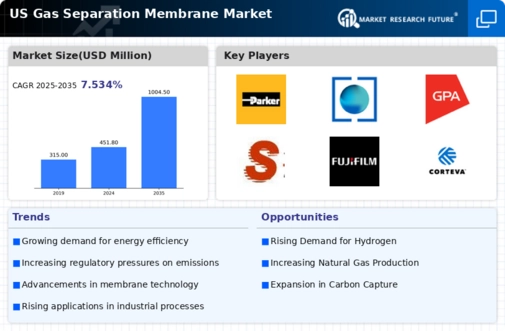The US Gas Separation Membrane Market is characterized by a competitive landscape that is shaped by key players that invest in technological advancements, product differentiation, and strategic partnerships to enhance their market positioning. As industries increasingly seek efficient and sustainable methods for gas separation, the demand for innovative membrane technologies is on the rise. Players in this market focus on developing high-performance membranes designed for various applications, including natural gas processing, hydrogen recovery, and carbon dioxide removal, making the market dynamic and responsive to evolving industrial needs.
The competitive insights reveal that constant innovation, robust supply chain management, and a commitment to sustainability are critical factors influencing the strategies of companies operating within this market.Asahi Kasei Corporation has carved a significant niche in the US Gas Separation Membrane Market, leveraging its advanced technological capabilities and strong research and development initiatives. The company is recognized for its high-performance membrane products that cater to a variety of industrial applications, contributing to increased efficiency and reduced operational costs for users.
Asahi Kasei’s emphasis on innovation allows it to maintain a competitive edge in the marketplace, while its established distribution networks enable a solid market presence across the United States. Additionally, the company’s focus on sustainability resonates with the growing emphasis on eco-friendly practices, further bolstering its reputation and market share in the gas separation segment. Parker Hannifin remains a formidable player in the US Gas Separation Membrane Market, possessing a robust array of technologies that enhance gas separation processes.
The company's product portfolio includes membranes and filtration systems that are designed to meet the stringent demands of various sectors such as petrochemical, natural gas, and environmental applications. Parker Hannifin's recognized commitment to research and development enables it to introduce advanced solutions that are aligned with industry advancements and customer needs. The company’s strong market presence is bolstered through strategic mergers and acquisitions aimed at expanding its capabilities and offerings in the gas separation technology domain.
Furthermore, Parker Hannifin is known for its customer-centric approach, backing its products with comprehensive support services that ensure optimal performance, thus reinforcing its reputation as a leader in the US market for gas separation membranes.



















Leave a Comment